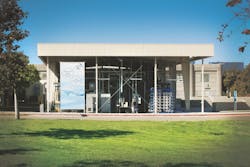About the author: Halla Razak is director of the City of San Diego Public Utilities Department. Razak can be reached at [email protected] or 858.292.6401.
With little rain and limited local water supplies, San Diego imports 85% of its water from the Colorado River and Northern California. The city is working to develop a local source of drinking water to lessen dependence on imported water, keep up with population growth and combat water supply reliability challenges, including recurring drought conditions.
From 2009 to 2013, the Water Purification Demonstration Project explored the feasibility of using water purification technology to purify recycled water and provide a sustainable source of drinking water for San Diego. The demonstration project proposed that purified water become part of the local water supply through indirect potable reuse (IPR). In IPR, purified water is added to an environmental buffer to combine with imported water sources before going through traditional drinking water treatment. In San Diego’s case, the environmental buffer would be the San Vicente Reservoir.
As part of the demonstration project, the city built and operated an advanced water purification (AWP) facility at the North City Water Reclamation Plant that purified 1 million gal of recycled water per day for one year using membrane filtration, reverse osmosis and advanced oxidation with ultraviolet light and hydrogen peroxide. After more than 9,000 water quality tests, the city confirmed that recycled water can be purified and safely added to the San Vicente Reservoir. In addition, multiple reservoir studies, regulatory coordination, an energy and cost analysis, and an education and outreach program were conducted. The California Department of Public Health and San Diego Water Quality Control Board approved the reservoir augmentation concept and concurred that the purified water meets all federal and state drinking water standards.
Moving Ahead
In April 2013, the San Diego City Council unanimously adopted the demonstration project report, and later launched Pure Water San Diego, a 20-year program to provide a local, safe and drought-proof drinking water supply for the city.
The city has been working to further define its water reuse strategy, which includes determining how to divert more wastewater for recycling and exploring direct potable reuse (DPR), in which purified water is sent directly from the water purification facility to a drinking water treatment plant (thus bypassing the reservoir).
Through grant funding made available by voter-approved Propositions 50 and 84, the city has partnered with the WateReuse Research Foundation to monitor, evaluate and demonstrate a test plan for DPR. Because no regulations currently exist for DPR in California, the city is testing ozonation and biological activated carbon filters as additional treatment barriers to possibly compensate for the absence of an environmental buffer and help define DPR regulations.
On Nov. 18, 2014, the San Diego City Council unanimously approved the renewal application for the modified permit for the Point Loma Wastewater Treatment Plant and approved the advancement of the Pure Water San Diego program. Point Loma is the largest wastewater treatment plant in the region, capable of treating 240 million gal of wastewater per day. The federal Clean Water Act requires all wastewater treatment plants to treat to secondary treatment level; however, San Diego has a permit that allows the city to treat to advanced primary level. The permit is due to be renewed in 2015. Upgrading the plant to current federal standards would cost $1.8 billion. Investing in the Pure Water program and seeking federal legislation to allow San Diego to meet modified secondary standards would eliminate the need for costly upgrades to the Point Loma Wastewater Treatment Plant.
Developing a Plan
The Pure Water program will divert approximately 100 million gal per day (mgd) from the Point Loma Wastewater Treatment Plant to three future advanced water purification facilities located at the North City Water Reclamation Plant, the South Bay Water Reclamation Plant and a future Harbor Drive facility. An initial 15-mgd water purification facility is planned to be in operation by 2023. The long-term goal—producing 83 mgd of purified water (one-third of San Diego’s future drinking water supply)—is planned to be reached by 2035. This local supply of water will help the city avoid purchasing costly imported water and improve the city’s water supply independence.
The city is developing the implementation plan for the initial full-scale, 15-mgd facility, and continues to operate the AWP facility. Free tours of the AWP facility are offered to members of the public as part of the outreach and education program component of Pure Water San Diego. During the tour, the water purification process is explained in detail and participants get an up-close look at the technology used. Since July 2011, more than 6,000 people have toured the facility.
In 2014, the city of San Diego received the American Water Works Assn.’s Public Communications Achievement Award and the California Water Reuse Assn.’s Recycled Water Community Outreach/Public Outreach Program of the Year Award for achieving communications excellence with its demonstration project’s public outreach program. The education and outreach program has increased understanding and approval of water purification, with public support rising from 26% in 2004 to 73% in 2012.
More information about Pure Water San Diego is available online at www.purewatersd.org. In addition, complete results of the demonstration project can be viewed and registration for free tours of the AWP facility is available.
Download: Here
